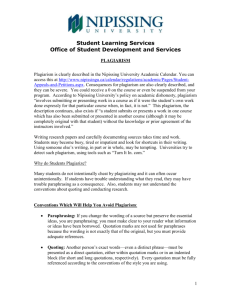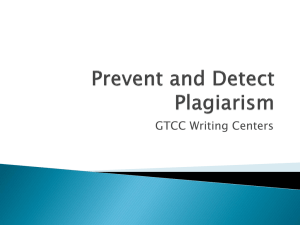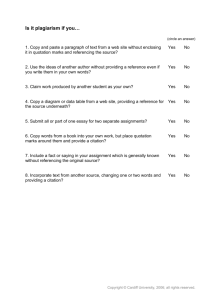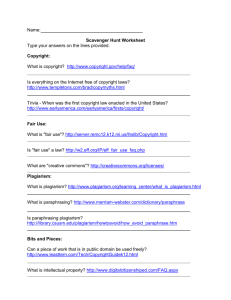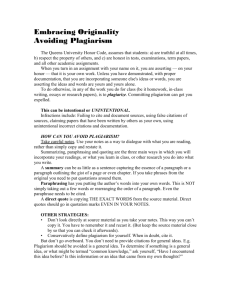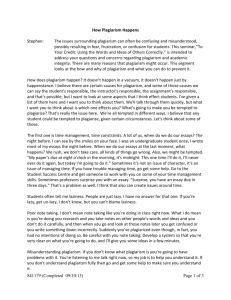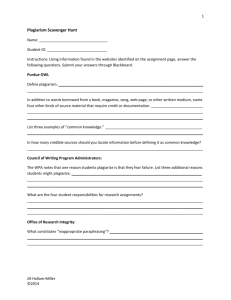Understanding Plagiarism and Paraphrasing
advertisement
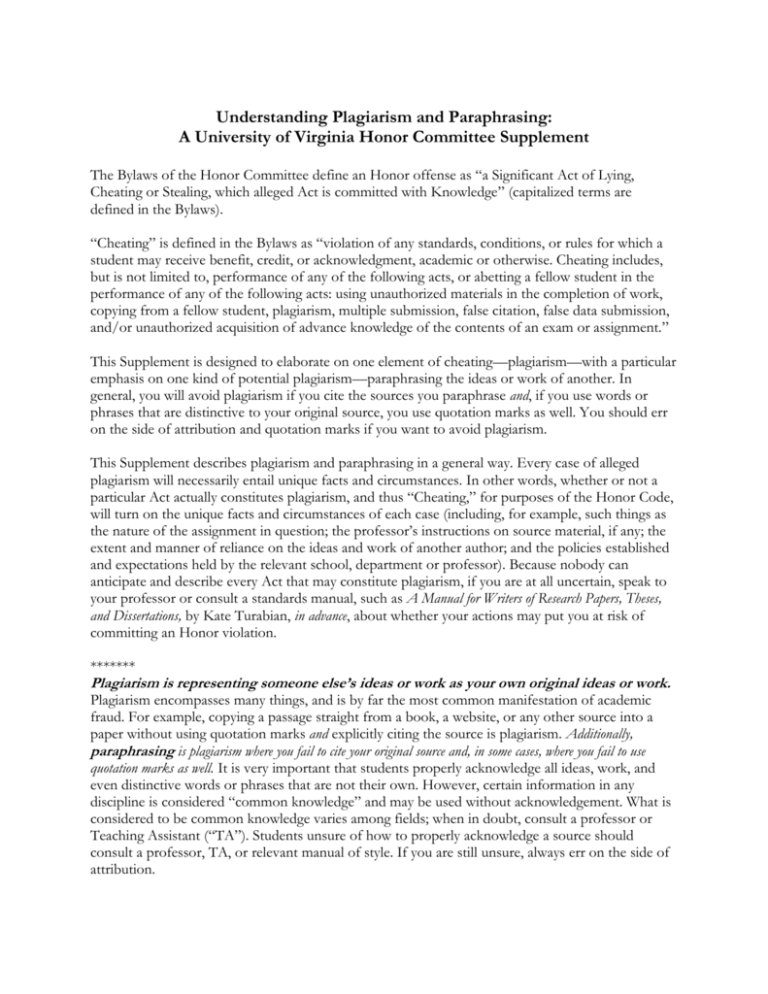
Understanding Plagiarism and Paraphrasing: A University of Virginia Honor Committee Supplement The Bylaws of the Honor Committee define an Honor offense as “a Significant Act of Lying, Cheating or Stealing, which alleged Act is committed with Knowledge” (capitalized terms are defined in the Bylaws). “Cheating” is defined in the Bylaws as “violation of any standards, conditions, or rules for which a student may receive benefit, credit, or acknowledgment, academic or otherwise. Cheating includes, but is not limited to, performance of any of the following acts, or abetting a fellow student in the performance of any of the following acts: using unauthorized materials in the completion of work, copying from a fellow student, plagiarism, multiple submission, false citation, false data submission, and/or unauthorized acquisition of advance knowledge of the contents of an exam or assignment.” This Supplement is designed to elaborate on one element of cheating—plagiarism—with a particular emphasis on one kind of potential plagiarism—paraphrasing the ideas or work of another. In general, you will avoid plagiarism if you cite the sources you paraphrase and, if you use words or phrases that are distinctive to your original source, you use quotation marks as well. You should err on the side of attribution and quotation marks if you want to avoid plagiarism. This Supplement describes plagiarism and paraphrasing in a general way. Every case of alleged plagiarism will necessarily entail unique facts and circumstances. In other words, whether or not a particular Act actually constitutes plagiarism, and thus “Cheating,” for purposes of the Honor Code, will turn on the unique facts and circumstances of each case (including, for example, such things as the nature of the assignment in question; the professor’s instructions on source material, if any; the extent and manner of reliance on the ideas and work of another author; and the policies established and expectations held by the relevant school, department or professor). Because nobody can anticipate and describe every Act that may constitute plagiarism, if you are at all uncertain, speak to your professor or consult a standards manual, such as A Manual for Writers of Research Papers, Theses, and Dissertations, by Kate Turabian, in advance, about whether your actions may put you at risk of committing an Honor violation. ******* Plagiarism is representing someone else’s ideas or work as your own original ideas or work. Plagiarism encompasses many things, and is by far the most common manifestation of academic fraud. For example, copying a passage straight from a book, a website, or any other source into a paper without using quotation marks and explicitly citing the source is plagiarism. Additionally, paraphrasing is plagiarism where you fail to cite your original source and, in some cases, where you fail to use quotation marks as well. It is very important that students properly acknowledge all ideas, work, and even distinctive words or phrases that are not their own. However, certain information in any discipline is considered “common knowledge” and may be used without acknowledgement. What is considered to be common knowledge varies among fields; when in doubt, consult a professor or Teaching Assistant (“TA”). Students unsure of how to properly acknowledge a source should consult a professor, TA, or relevant manual of style. If you are still unsure, always err on the side of attribution. It may be appropriate to paraphrase a source when you can represent what a source says more clearly or pointedly in your own words. Paraphrasing does not mean merely changing a word or two or re-ordering the concepts in a passage; you must use your own words and your own phrasing to replace most of the words and phrasing of the source. Remember: Even paraphrased sources MUST BE CITED. Plagiarism by paraphrasing occurs when you paraphrase a source and fail to cite it. In addition, even where the original source has been cited, plagiarism occurs where you fail to use quotation marks around words or phrases that show the author’s distinct and original thought or expression (of course, you should not put quotation marks around words or phrases that are not exactly those of the author – this would constitute false citation). While determining whether certain words warrant quotation marks might seem dependent on the reader, you should always use quotation marks when in doubt. Additionally, in certain specialized fields, such as law or business, close paraphrasing may be considered acceptable; in such cases, the relevant facts and circumstances will, as in all cases, inform the question whether a particular Act constitutes plagiarism. Take, for example, this passage: Because technology begets more technology, the importance of an invention’s diffusion potentially exceeds the importance of the original invention. Technology’s history exemplifies what is termed as autocatalytic process: that is, one that speeds up at a rate that increases with time, because the process catalyzes itself (Jared Diamond 1998, 301). At least two of the author’s phrases are so striking that any use of these phrases would definitely require quotation marks: “technology begets more technology” and “autocatalytic process.” To cite Diamond’s passage appropriately, one possible sentence could look like this: The power of technology goes beyond individual inventions because technology “begets more technology.” It is, as Diamond puts it, an “autocatalytic process” (301). Once the distinctive phrase has been cited, you may use it again without quotation marks or citation. You paraphrase appropriately when you represent an idea in your own words more clearly or pointedly than the source does. Remember: Even an appropriate paraphrase requires citation to the original source. But readers will think you crossed the line from fair paraphrase to plagiarism, even though you have cited the original source, if they can match your words and phrasing with those of your source. Whether or not the line has been crossed will be decided on a case-by-case basis; since the facts and circumstances of each Honor case are unique, it is impossible to anticipate and describe every example of paraphrasing that may constitute plagiarism. The important question is whether you have represented someone else’s ideas or work as your own original ideas or work. In some cases, even where you have cited the original author, you may, in the manner and extent to which you go on to convey the author’s ideas, be found to have represented that author’s ideas or work as your own. This might be the case, for example, where you cite the original author one time, at the beginning of a 10-page paper, then, after leaving the topic, return to the author’s ideas, time and again, without indicating to the reader that you have done so; that is, the reader would reasonably infer that your reference to the original author had ended and that later paraphrases of the author’s ideas or work were in fact your own original ideas or work. In each case, an I-Panel, and, if applicable, a jury, will be asked to decide whether, in the totality of the circumstances, you have misrepresented the author’s original ideas as your own. ******* Here are two examples of appropriate and impermissible paraphrasing designed to help you better understand what plagiarism by paraphrasing would look like, together with some suggestions on how to avoid it. Example 1: Original Source Material: Developing complex skills in the classroom involves the key ingredients identified in teaching pigeons to play ping-pong and to bowl. The key ingredients are: (1) inducing a response, (2) reinforcing subtle improvements or refinements in the behavior, (3) providing for the transfer of stimulus control by gradually withdrawing the prompts or cues, and (4) scheduling reinforcements so that the ratio of reinforcements in responses gradually increases and natural reinforcers can maintain their behavior. Source: Gredler, M. E. (2001). Learning and instruction: Theory into practice (4th ed.). Upper Saddle River, NJ: Prentice-Hall. Plagiarized Version: Inducing a response, providing for the transfer of stimulus control by gradually withdrawing prompts or cues, reinforcing subtle improvements in the behavior, and scheduling reinforcements so that natural reinforcers can maintain their behavior are the key ingredients identified both in teaching pigeons to play ping-pong and in developing complex skills in the classroom. Explanation: This example has been plagiarized. The student has only moved the original author's words around, inserting and deleting small portions as needed. The student has not used quotation marks for the portions that are still identical to the original, and has not credited the original author. Unplagiarized Version: According to Gredler (2001), the same factors apply to developing complex skills in a classroom setting as to developing complex skills in any setting. A response must be induced, then reinforced as it gets closer to the desired behavior. Reinforcers have to be scheduled carefully, and cues have to be withdrawn gradually so that the new behaviors can be transferred and maintained. Explanation: This example has been paraphrased and is not considered plagiarized. The author was cited at the beginning of the passage (and should be cited in any bibliography as well). Since the passage was properly paraphrased, quotation marks are not used. Nothing was directly quoted. Example 2: Original Source Material: During the last decade, there has been a shift from “instructivist” towards “constructivist” approaches in the field of instructional design. Instructivist approaches reflect the belief that the role of knowledge is basically to represent the real world. Meaning is eventually determined by this real world and [is] thus external to the understander. Source: Merriënboer, J. J. van. (1997). Training complex cognitive skills. Englewood Cliffs, NJ: Educational Technology Publications. Plagiarized Version: Over the last ten years, there has been a marked change from “instructivist” points of view to “constructivist” points of view among instructional designers. Instructivist points of view hold the belief that the role of knowledge is fundamentally to represent the real world. In this view, meaning is determined by the real world and is therefore external to the learner. Explanation: This example has been plagiarized. The student has substituted synonyms for many words in the passage, but has not changed the structure of the text and has used another person's ideas without crediting that person for them. Unplagiarized Version: Instructivists hold that the “real world,” external to individuals, can be represented as knowledge and determines what will be understood by individuals. This view has been shifting to a constructivist view over the past decade (Merriënboer, 1997). Explanation: This example has been paraphrased and the original author has been credited for those ideas. The student has cited the source of the ideas appropriately (and should include the information in a bibliography, if any). ******* One suggestion for avoiding plagiarism in paraphrasing is to avoid reading your source as you paraphrase it. Read the passage, look away, think about it for a moment; then, still looking away, put it in your own words. Then check whether you can run your finger along your sentence and find the same ideas in the same order in your source. If so, you have crossed the line into plagiarism. Finally, remember, even if you have correctly paraphrased your source—that is, even if quotation marks are not necessary— you must also cite the source from which you have taken the ideas or information to begin with. In short, when in doubt about paraphrasing, use quotation marks around words or phrases that are distinctively those of the original author and properly acknowledge (cite) the original source. Note: This supplement was created in consultation with Gregory C. Colomb, Professor of English at the University of Virginia, and draws heavily from the 7th edition of A Manual for Writers of Research Papers, Theses, and Dissertations, by Kate L. Turabian, revised by Wayne C. Booth, Gregory C. Colomb, Joseph M. Williams, and the University of Chicago Press Editorial Staff.
